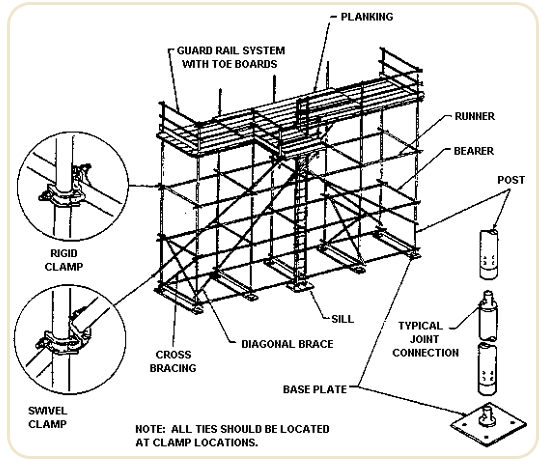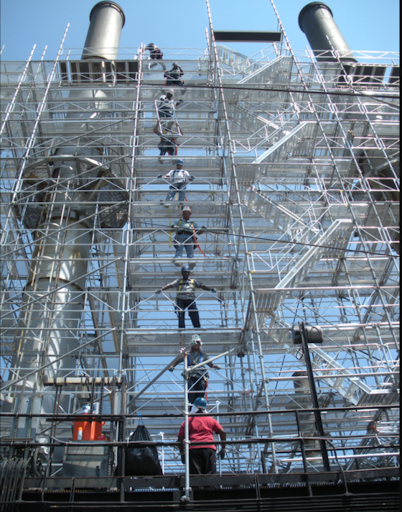Find Reliable Scaffolding Services in Surrey for Your Project Needs
Find Reliable Scaffolding Services in Surrey for Your Project Needs
Blog Article
Checking Out the Different Types of Scaffolding Utilized in Building And Construction Jobs
The building and construction sector depends heavily on numerous types of scaffolding to meet particular job needs, each offering distinct advantages and applications. Traditional structure scaffolding gives a tough foundation for basic tasks, while suspended scaffolding is necessary for deal with high-rise frameworks. Other alternatives, such as system and rolling scaffolding, deal with performance and flexibility, respectively. In addition, the cantilever variant proves important in city atmospheres where space is constricted. Comprehending the subtleties of these scaffolding types is essential for optimizing security and performance on building and construction sites, triggering a closer evaluation of their one-of-a-kind attributes and applications.

Standard Frame Scaffolding
Typical framework scaffolding is just one of the most widely utilized approaches in the building and construction sector as a result of its effectiveness and versatility. This system contains horizontal and upright structures that are set up to develop a secure system for materials and employees. The major elements consist of upright messages, horizontal journals, and diagonal dental braces, which together give a solid framework that can support substantial tons.
Among the vital benefits of standard frame scaffolding is its versatility to numerous building tasks, ranging from property buildings to big business structures. The modular design permits very easy assembly and disassembly, making it effective for both lasting and short-term jobs. In addition, the system can be customized in height and size, suiting different building styles and site problems.
Safety and security is vital in scaffolding applications, and traditional framework systems are outfitted with guardrails and toe boards to stop falls and guarantee employee protection. In addition, regular assessments and adherence to safety and security regulations are vital in keeping the integrity of the scaffold. On the whole, typical frame scaffolding continues to be a fundamental choice in the building market, offering a trustworthy system for labor and improving general project efficiency

Suspended Scaffolding
Put on hold scaffolding uses a special service for construction tasks that need access to raised surfaces, particularly in situations where typical framework scaffolding might be impractical. This kind of scaffolding is normally suspended from the roofing or top levels of a framework, utilizing a system of sheaves, ropes, and systems to produce a working space that can be adapted to different heights.
Among the key benefits of put on hold scaffolding is its adaptability. It can be easily repositioned or lowered to fit modifications in construction requirements, making it ideal for tasks such as window setup, frontage job, and upkeep on high-rise buildings. Furthermore, the marginal impact of put on hold scaffolding permits better use ground space in city atmospheres, where room is typically minimal.
Security is a critical consideration in the use of suspended scaffolding. Generally, suspended scaffolding provides a reliable and effective solution for accessing hard-to-reach locations in various construction circumstances, improving both productivity and security on website.
System Scaffolding
System scaffolding, often regarded as a modern-day option in the scaffolding market, contains pre-engineered elements that can be quickly constructed and adapted for numerous building tasks. Scaffolding. This kind of scaffolding is identified by its modular style, which permits for flexibility and performance on job websites, suiting architectural needs and different elevations
Commonly made from high-strength steel or light weight aluminum, system scaffolding uses enhanced resilience and security. The elements include vertical messages, straight ledgers, and angled dental braces, which adjoin safely, making certain a durable structure. The design usually site here incorporates standard installations, simplifying assembly and disassembly processes, consequently reducing labor time and costs.

Rolling Scaffolding
Rolling scaffolding is a versatile option to standard set scaffolding, designed for movement and simplicity of use on building websites. This sort of scaffolding includes a system sustained by frames with wheels, allowing workers to quickly move it as required. The mobility function dramatically improves productivity, as it decreases downtime related to constructing and dismantling dealt with scaffolding.
Normally created from lightweight materials such as aluminum or steel, rolling scaffolding uses a tough yet portable remedy for projects needing regular repositioning - Scaffolding. It is particularly beneficial in tasks such as paint, drywall setup, and electric work, where access to numerous elevations and locations is necessary
Safety is paramount article source in rolling scaffolding layout, with functions such as locking wheels to stop unexpected motion when in usage, and guardrails to shield workers from falls. Furthermore, lots of versions are flexible in height, accommodating different task demands.
Cantilever Scaffolding

The design of cantilever scaffolding commonly entails using braces or arms secured to a building or framework, allowing the system to prolong exterior securely. Safety is extremely important; therefore, these scaffolds must be crafted to withstand environmental problems and various lots. Routine evaluation and maintenance are vital to ensure architectural stability and worker safety and security.
Cantilever scaffolding is favored for its adaptability and effective use of space, making it a preferred option in urban settings where area restraints are usual. It helps with much easier accessibility to high elevations, eventually contributing to the general performance of building and construction projects. As with all scaffolding types, proper training and adherence to security criteria are crucial for employees utilizing cantilever scaffolding.
Conclusion
In final thought, the varied kinds of scaffolding utilized in building and construction tasks each offer distinctive objectives customized to certain website demands. Standard framework scaffolding find more information supplies stability, while suspended scaffolding offers versatility for raised jobs. System scaffolding assists in quick assembly, and rolling scaffolding improves wheelchair for varying work environments. Cantilever scaffolding successfully attends to obstacles in urban setups. Recognizing these scaffolding kinds is necessary for maximizing security and productivity in construction, ultimately adding to the successful conclusion of jobs.
Standard framework scaffolding gives a sturdy structure for basic tasks, while suspended scaffolding is crucial for job on high-rise structures.Rolling scaffolding is a versatile alternative to typical set scaffolding, created for movement and convenience of use on building and construction websites. As with all scaffolding types, appropriate training and adherence to security criteria are crucial for workers using cantilever scaffolding.
Typical frame scaffolding provides stability, while suspended scaffolding supplies flexibility for raised jobs. System scaffolding assists in fast assembly, and rolling scaffolding enhances mobility for differing job environments.
Report this page